Dear Reader, in this age of AI created content, please support with your goodwill someone who works harder to provide the human-made. Sign up in the righthand column or bottom of this page. You will receive my hand illustrated monthly newsletter RESTORE NATURE and access to the biodiversity garden design course as I write...and nothing else, I respect your time.
the garden pond as aquatic food garden and man made ecosystem
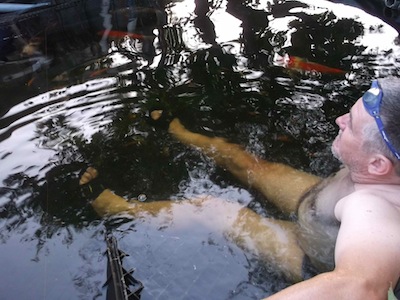 The cool waters of the garden pond - swimming pool - fish pond
The cool waters of the garden pond - swimming pool - fish pondHaving a garden pond can become part of your lifestyle.
With me its really my husband’s fault. First he raised guppies in a tank, then we bought some Koi and I built a small pond. Then he worked for a Koi breeder with a big farm and mud dams and was taught by a Japanese breeder who flew in to trouble shoot, and he started raising worms and continued to become a vermi culturist and backyard koi breeder. The positive result of all of this is that we’re not afraid of water systems and it helped pay off the bond.
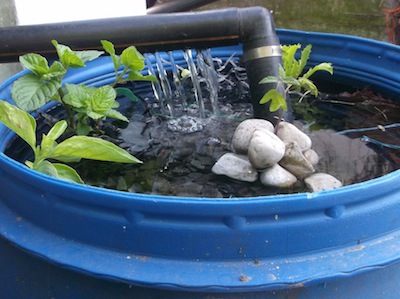 just after planting the barrel just after planting the barrel |
 the mint a few months later the mint a few months later |
Most recently we’ve ventured into aquaponics, and got as far as growing plants in the secondary filters, in plastic barrels. The mint is huge, the bullrushes were problematically enormous. I've learned from a friend who is continually experimenting with aquaponics.
Easy aquaponics integrated with the garden pond
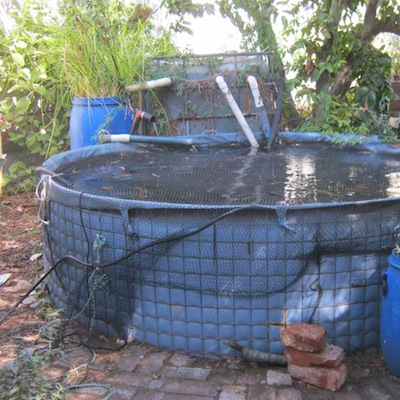 the existing 'top' fish pond the existing 'top' fish pond |
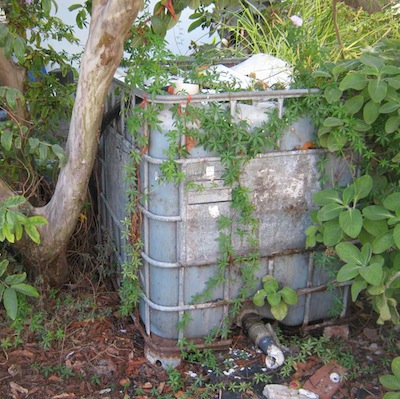 existing natural bio filter existing natural bio filter |
The above system is very low maintenance. You can see the two pipes coming from the biofilter back into the pond, and the pipe coming from the vegetation filter containing Cyperaceae.
With ease of management in mind, I have designed a new, expanded system and will start building soon. We used to have four tanks and this was better for managing fish breeding.
I wish to add a second pond, bio filter and vegetations beds to the present fishpond and bio filter, all driven by the same pump, and using gravity feed to get water from one tank to the other. We will than have two fishponds with a total capacity of about 15 cubic metres, plus two bio-filters each a cubic metre and a series of six growing tanks on an ebb and flow aquaponic system, driven by a small second pump on a timer.
For this ebb and flow action in the grow beds, bell siphons are ideal but they are just too sensitive to a multitude of factors and so hard to get right. You can make them out of throwaway plastic parts, but we’ve tried repeatedly without producing a reliable result, and so has our friend who is a mechanical and technical genius. Unfortunately we need to get on with the growing system using our power supply and hopefully one day we’ll build a predictable bell siphon.
The fish population in this aquaponic system will be low, whereas most aquaponic systems carry a high load of fish to provide enough N, but which makes them unstable, as a broken pump can mean massive fish death. We want a system that will not kill the fish if it breaks down while we are out for the night. This system will be a hybrid system. It will consist of a low fish population aquaponic system, a natural swimming pool and a fish pond with totally recyclable water, not requiring water replacement due to N buildup, all rolled into one.
Our future new-old garden pond
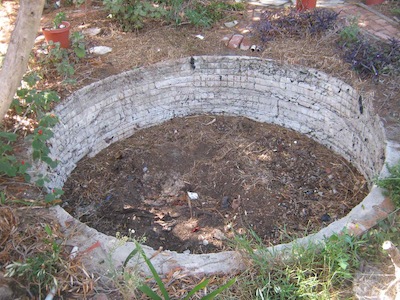 the old 'bottom' pond lined with brick and plaster
the old 'bottom' pond lined with brick and plasterI intend using the shell of our old bottom pond, building it up, adding a second circular wall outside this, placing the grow-beds between the two walls and connecting everything in the grow-beds, backfilling with sand from the pond and then getting the connections ready to the top pond and the bio-filters, with valves on them perhaps. Once we’ve placed the bottom drain in the bottom pond (so called as it is lower and the final drainage point before pumping back up to the first bio-filter) I will line it with a custom made PVC liner, and we can seal the connections, connect it to the top pond, fill it with water and start the system.
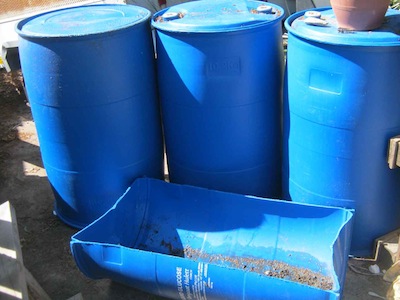 barrels to make grow beds barrels to make grow beds |
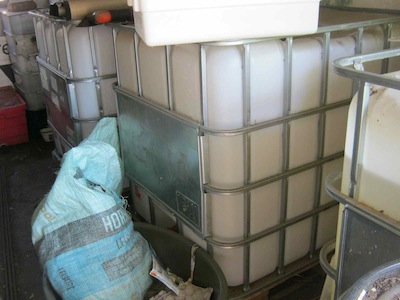 empty cubic tank for filter empty cubic tank for filter |
 bricks for pond construction bricks for pond construction |
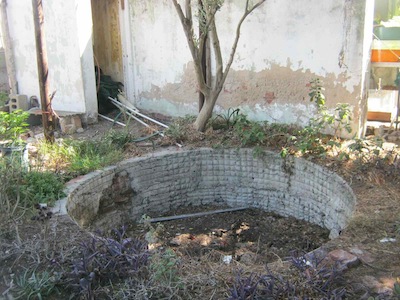 bottom pond context bottom pond context |
This is all good, but what it misses is the total aquatic eco system, with frogs, dragon flies and all the small creatures in such a system. This isn’t really possible without still water, and systems that support Koi fish require fast moving water for oxygen.
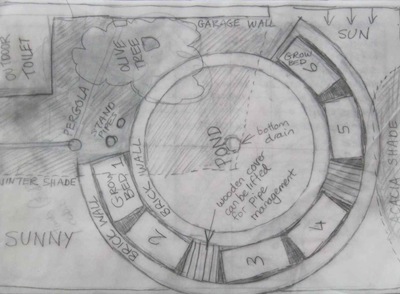 rough sketch of bottom pond with grow beds, thanks to Marc
rough sketch of bottom pond with grow beds, thanks to MarcIf the grow beds do not enrich our eco system sufficiently, I’m thinking of adding some kind of a side pond that completes the system in this way, a part that takes pond runoff, or even gray water, added slowly, and constantly, and does not feed back into the main system, as a stagnant pond will be a breeding ground for Koi pathogens. I would love to recycle our gray water, but the dirty soapy water will not be good for the Koi, so these two aspects still need careful thought in order to integrate them.
In the meantime I will overview some ponds I’ve photographed in the recent months. I love water gardens, so I can’t refrain from snapping one I like.
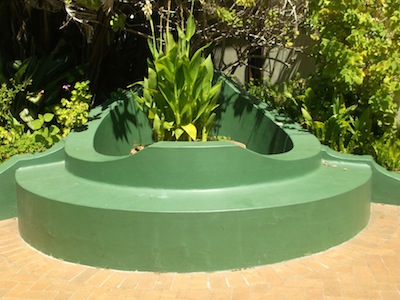 A shapely water well at the Irma Stern art museum
A shapely water well at the Irma Stern art museumThe green walls above surround a well at the Irma Stern museum. It was the artist's house and she bequeathed it to the nation.
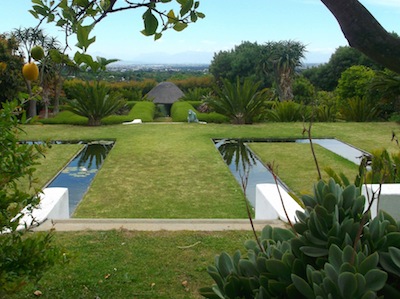 shallow linear garden pond creates expansive reflections
shallow linear garden pond creates expansive reflectionsThis clever garden pond design is a long channel only two feet wide and two feet deep. Yet it creates a racetrack for the fish and a vast open space reflected in water, while its straight lines frame the view with patches of blue sky and direct our attention at the horizon.
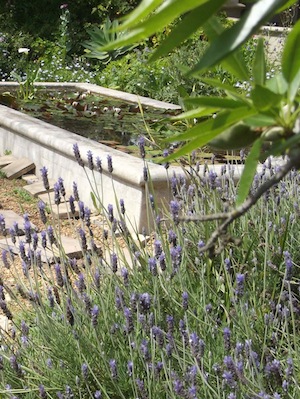 Aponogeton distachyos, an edible native water plant grows in this lovely garden pond
Aponogeton distachyos, an edible native water plant grows in this lovely garden pondRaised from the earth with retaining walls of unpainted but graciously bevelled concrete, this garden pond is also long and narrow. It is full of waterlilies, iris and white flowered Aponogeton distachyos surrounded by a mix of blue and white native and exotic flowers.
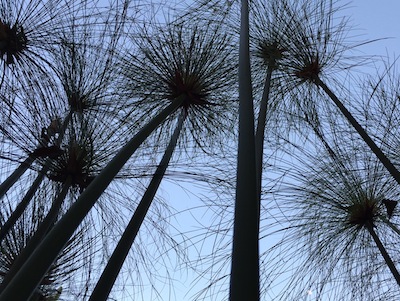 Majestic Cyperus papyrus San Diego. Its tuber is edible.
Majestic Cyperus papyrus San Diego. Its tuber is edible.I am busy researching what edible plants can be grown in the new system I'm planning, and there are many options, but as can be expected the quota or knowledge of edible aquatic native plants from South Africa is small.
Starting with native plants there is the water-uintjie or water ‘onion’ Aponogeton distachyos, which is available commercially in South Africa, and an element of traditional Cape cuisine. Its flower buds are best braised with aromatic Karoo mutton. Then there is the arum lily Zantedeschia aethiopica of which young leaves are eaten only when well cooked. Berula erecta is a medicinal herb for treating toothache, hence its Afrikaans name tandpynwortel (toothache root).
Plants from the same families as certain indigenous species are eaten elsewhere in the world and some experimentation and research will be needed to find out if the local varieties are also edible. Papyrus tubers (Cyperus), Nymphaea roots (water lilies), multiple parts of Phragmites and Typha (reeds).
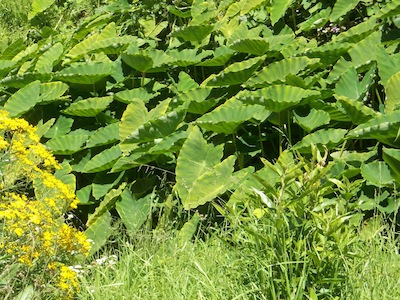 What looks like Taro, flourishing in a stream in Cape Town
What looks like Taro, flourishing in a stream in Cape TownOther plants are already naturalized weeds and a little exploration will reveal how useful they could be in a permacultural aquatic system. Colocasia esculentum (Taro) or a look alike seems to have invaded certain river systems in Cape Town. Its close relatives certainly grow here well, I will need to see if these are edible species and varieties.
Some types of cranberries like Vaccinium palustre can grow in water gardens.
There are various herbs which grow well in water, from England Salomus valerandi or Brook weed, Nasturtium officinale or Watercress, Pistia stratiotes or water lettuce, Lemna minor or Duckweed, Mentha aquatica or water mint, Mentha pulegium or Penny Royal, and from warmer regions Ipomoea aquatica or water spinach, Bacopra monniera, Aethionema cordifolia or Lebanese Cress, Polygonun odoratum or Vietnamese Mint, Oenanthe javanica or water parsley and Centella asiatica or Asian Pennywort can all be eaten, some as herbs and some as vegetables. The young shoots of Pontederia cordata or Pickerel Rush can be eaten and its seeds are also edible.
Some of these foods may be pushing the boundaries of what is edible but I would of course like to grow the classic marsh food, like the lotus Nelumbo nucifera, wild rice, Zizania latifolia, Taro (see above), and water chestnuts, although there is some confusion as to their identity. Water chestnut is seemingly a polysemous word and used for the Taro as well as for Trapa natans and Eleocharis dulcis. Confusion reigns now but more research will reveal the identity and availability of these plants, as well as their suitability for growing in a garden pond of a few cubic metres. Trial with lots of error is the spirit of gardening.
------
home page for links to informative pages on natural gardening
------
natural garden design and gardening practice
------
and album of edible water plants pinned on pinterest
Restore Nature Newsletter
I've been writing for four years now and I would love to hear from you
Please let me know if you have any questions, comments or stories to share on gardening, permaculture, regenerative agriculture, food forests, natural gardening, do nothing gardening, observations about pests and diseases, foraging, dealing with and using weeds constructively, composting and going offgrid.
SEARCH
Order the Kindle E-book for the SPECIAL PRICE of only
Prices valid till 30.09.2023
Recent Articles
-
Geography Research Task
Jan 31, 25 11:37 PM
To whom it may concern My name is Tanyaradzwa Madziwa and I am a matric student at Springfield Convent School. As part of our geography syllabus for this -
Eco Long Drop Pit Latrines Uganda
Nov 29, 24 02:45 AM
Good evening from the UK. My name is Murray Kirkham and I am the chairman of the International and foundation committee of my local Lindum Lincoln Rotary -
Landscape Architect
Oct 01, 24 10:42 AM
I so appreciate your informative description! Your experimentation and curiosity with the seeds, germination, and rearing of the maggot are exciting to
"How to start a profitable worm business on a shoestring budget
Order a printed copy from "Amazon" at the SPECIAL PRICE of only
or a digital version from the "Kindle" store at the SPECIAL PRICE of only
Prices valid till 30.09.2023





